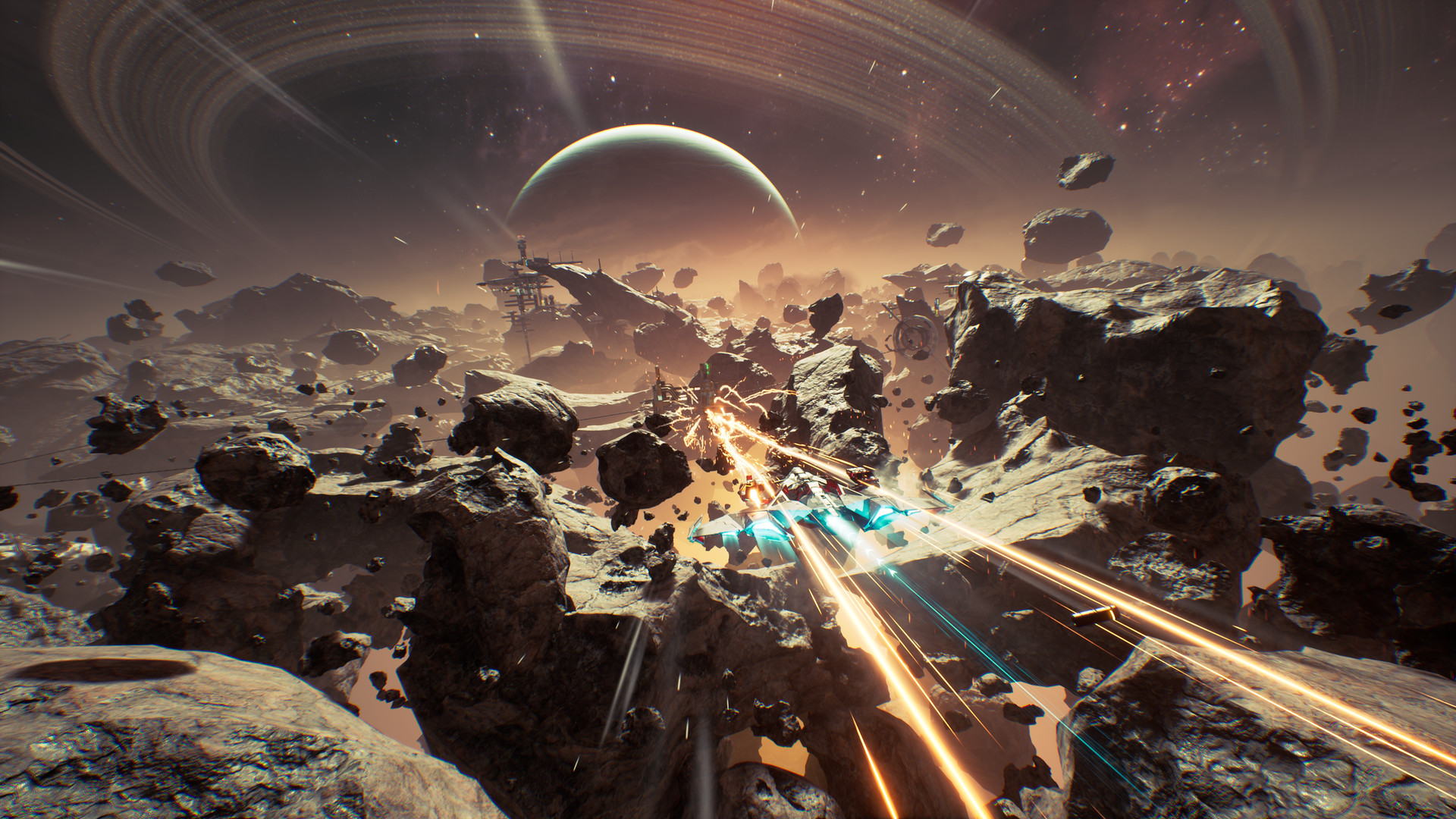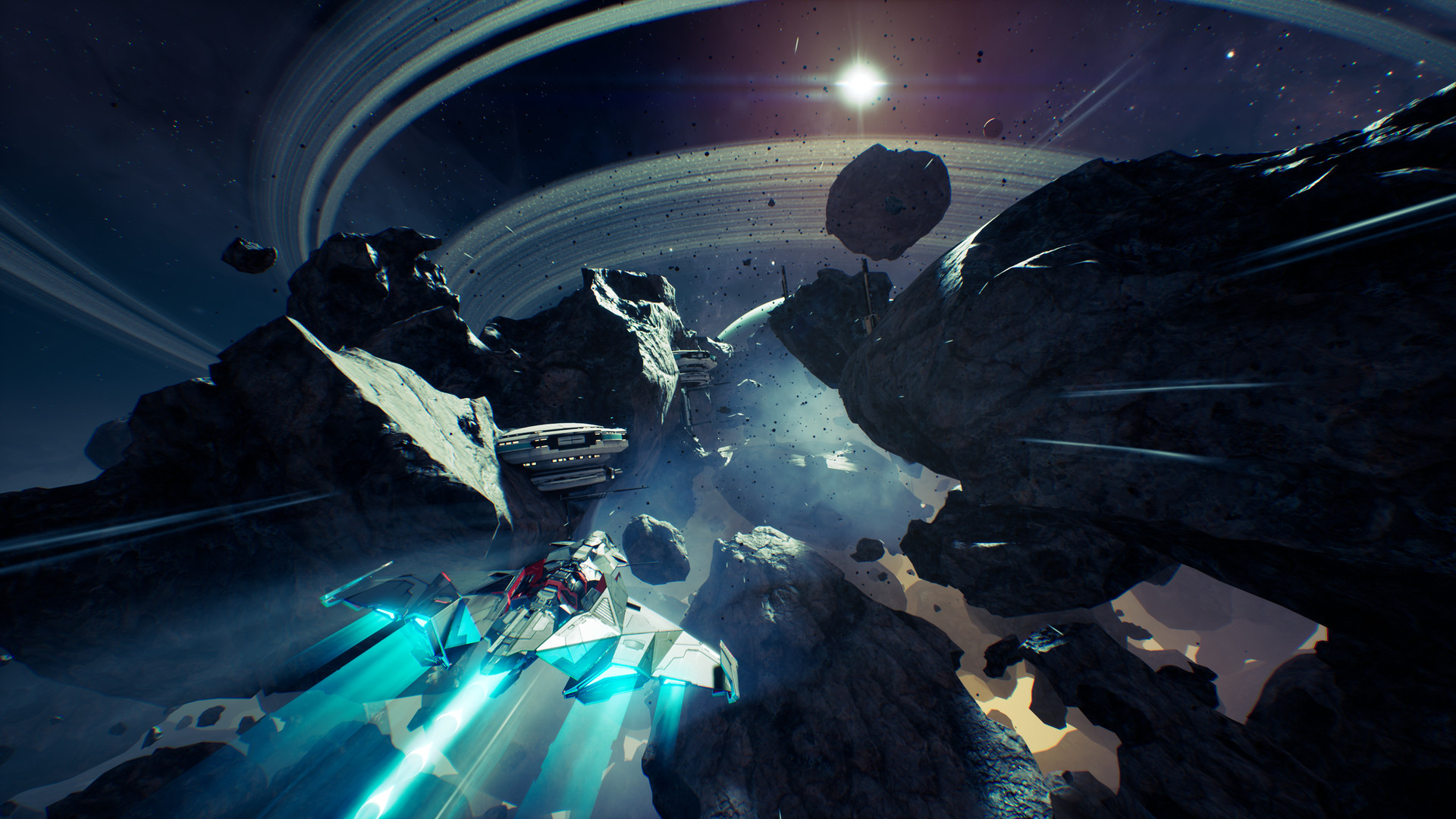Flying a spaceship has always been a cool idea for a video game and yet, it’s such a small market of games. Don’t get me wrong, the game pool may be shallow for recent titles to pick from, but the fan base for this genre is very strong and quite vocal. Fishlabs have predominately been a mobile game developer, working on the Galaxy of Fire series, and now get to release an epic in the same vein named Chorus. Published by Deepsilver, this third-person space action-adventure takes flight on PC and all current Xbox and PlayStation platforms.
I have always been a sucker for Science Fiction, being able to throw caution to the wind and suspend my disbelief is such a freeing feeling. Chorus leaned heavily into the sci-fi from the get-go with a storyboard-style opening introducing Nara, a pilot skilled well beyond her age that could leave the likes of Maverick in the dust. Her ship being a sentient creation named Forsaken, combined with her psychic abilities made her a formidable force for the Circle – a cult with the false promise of harmony among the stars, a Chorus. After her actions directly lead to the destruction of a planet and her guilt threatens to consume her, she abandons her post and vows to never return to the rule of the Great Prophet.
This is where the game picks up with Nara working as a freelance pilot on the outskirts of nowhere for the rebel force based at the Enclave. Starting in the graveyard of a wrecked megastructure, a basic tutorial guides you through movement, exploration, and how to read the stylised heads-up display. Being able to control the basic thrust with the left thumbstick and being able to stop completely without aimlessly floating was already a massive bonus in my books.

A quick flick on the same thumbstick let me barrel roll like the old Lylat Wars, and having three different weapon types made combat a game of chaotic chess. Breaking shields with the laser, drilling them with a gatling gun, and hurling a barrage of rockets to finish them off was fluent with how easy switching weapons with the D-Pad felt.
There was a natural progression of levelling as well, which just came about using any given weapon as opposed to having to manage a branching skill tree. A handy scan feature was also shown off to help find hidden objects or side quests that usually led to credits that can be cashed in for ship upgrades.
When Nara’s old life catches up to her she must embrace her past and link up with her abandoned ship, Forsaken, and attempt to reconnect with the Ether to master her powers known as Rites. These powers offer subtle yet clever ways to keep you in the fight and track your enemies during the wild dog fights. You can literally teleport behind an enemy within range to re-align yourself.
I can’t stress how amazing this small feature is as it’s not overpowered and incorporates a life improvement feature on flight controls while tying it to the narrative of the game. Furthermore, once you master the drift feature you can boost up to an enemy and turn on a dime to attack their weak points before darting off, it took a lot of practice but eventually, a simple fight with a group of pirates can inspire montage worthy moments. I felt confident to attempt these impressive manoeuvers due to the forgiving checkpoint system. Even when I died, I rarely had to backtrack too far to get right back into the action.

Coming from the dark and grim cutscenes which focus on a battle-scarred Nara, an interstellar level soundtrack is used to emphasise the bleak and harrowing narrative. The illuminated and expansive universe presented was breathtaking at first sight. I let out an audible “wow” each and every time I reached a new section of the game as the cosmic glows changed hue depending on the planets that were nearby. Despite the crisp and dynamic lines of your ship and the structures, including the bases built into the asteroid field, combat maintained a more arcade vibe with bright red neon lights tracking the ships and the psychic abilities emitting a cold blue effect. There were a few sections where the frame rate fluctuates, but with the amount of particle physics and god rays scattered across the battlefield, it was understandable and would hardly ever interrupt gameplay.
The most polarising part of the game was the characters and overall story elements. I personally really bought into the open-world environments that let you explore freely to pick up side quests at your leisure and meet a slue of characters. Nara is really the only character that you actually see, however, as everyone else is just a small picture on the bottom of the screen as you talk over the radio. The dialogue was well written and the voice acting gave them life, from desperate pleas for help, or vulgar taunts from local pirates. The big hit and miss component was Nara herself, she would constantly talk to herself and her inner monologue was a breathy mystical delivery that could either set the tone or break the immersion, depending on your mood.
Chorus is a true space adventure in an open-world setting that continuously surprised me and offered challenging obstacles for me to tackle. Learning how to properly control Forsaken and master my Rite abilities made this game stand out amongst its competition. I don’t think I would ever be able to attempt the permadeath mode, however, as there were a few sneaky boss fights thrown in the mix that had me dying a few too many times for my liking. Considering the scope of this game, the fact that it’s half the price of a AAA game on launch is an absolute steal and will pay dividends to those who stick with it.

The Good
- Giant and expansive open space to explore
- Tight, nimble and satisfying combat once mastered
- Excellent voice acting
- Rites offer ground breaking abilities for flight controls
- Cinematic and montage worthy moments come often
- Art style is crisp, realistic and arcade like at the same time
The Bad
- Nara talking to herself constantly is hit and miss
- Steep learning curve can be frustrating early on
- Nara is the only character you ever see outside her ship








